#Gekijo
Photo
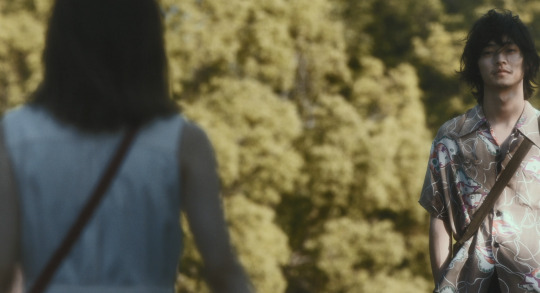







2020 劇場 Gekijo
Theater
18 notes
·
View notes
Text
2024.02.16-17 sukekiyo at Kyoto Gekijo
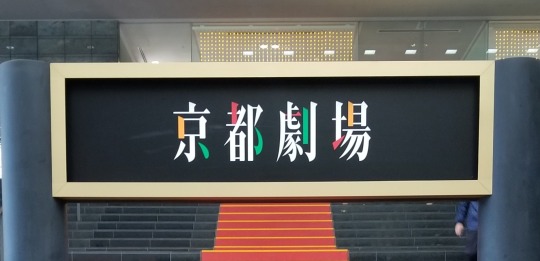
I really wanted to write about each show separately but then the 17th was filled with too many exciting things and there was no time. So I'll try about them together. And because of the setlists it also feels like they both belong together anyway.
2.16
The first day flow felt like the young idol started bright and excited, innocent, but then fell, experiencing the dirty side of love and people, but wanted to find love somehow anyway. And it finished with 呼吸・kokyuu...
As the BGM they are playing another movie (sound only).
5 minutes to and then at 6:30 the theatre buzzer sounded to signal the start of the show.
They had the usual see through screen in front of the stage (always done for the seated shows). sukekiyo and the tour name appeared as the snow was softly falling in the dark. At the same time band members walked on the stage, Takumi first, followed by Yuchi and Mika, then utA and Kyo last.
And Takumi started the piano melody of Margaret. It's so nice that they again chose to start with the last song from the previous tour, like they're creating a connection between then and now.
The stage was mostly their normal setting, but Kyo's stand had a dark bouquet laying in the middle of the table, I'm pretty sure it was the one with the doll in it that he shared in his Instagram story. There was also a high chair on the right side of his stand, right next to it.
And a new addition were big light bulbs hanging on wires over the stage, one over each band member hanging lower and four more a bit higher, nine in total. When グロス・Gloss started they lit up but dimmed when song got quieter.
During 愛した心臓・Aishita shinzo Kyo was dancing, he also came close the screen stretching his arm towards audience.
(but I'm always unsure how much they can see from the other side because of how the light works on the screen), he crouched when dancing. Kyo was very dancey, utA as well (I was sitting on utA's side that night, aisle seat though).
They all wore outfits from their last artist photos. utA's hair was more standing, full 90s visual kei style.
Kyo changed his look having a very different hairstyle. Because he shaved his head to get a new tattoo in January his hair is still very short, like in Citta he glued things on though, for sukekiyo he had two thin pink braids, one on each side, styled in a way they created two rings. And he had the porcelain doll effect make up, shiny face with drawn eyebrows, dark eye make up and full lips. The back of his dress is quite open so we could see his tattooed back. And he wore pink tabi boots to complete the look.
(you can check those tweets 1️⃣ 2️⃣ to see fans drawings of him, just pls don't repost)
Both Candis and Valentina were quite fun with the pen lights. And this part had a lot of dancey songs that even come with set dance moves... But since it was a seated show it was only Kyo dancing, with other band members rocking and jumping as well, fans had to endure and stay in their seats😂
With 口に林檎・kuchi ni ringo the stage went darker and Kyo was lit up by his mic stand's pink light. aftermath followed with the soft dark mood in the venue and the video on the screen. Some of the autumn temple has been edited and changed to pink cherry blossoms with petals scattering. Kyo sang standing by his mic stand, illuminated in pink.
And after the song ended Takumi played the piano melody that starts the session. Kyo softly walked towards the chair and sat with one leg over the other, very dignified, like a film noir singer or a diva. A black clothed staff member walked on the stage from the left side holding a make up case and started to 'do' Kyo's make up. He patted Kyo's face with a towel, he then used a sponge and a brush, then 'did' Kyo's lips. I don't think he actually changed anything but it was a part of the performance. Kyo stayed seated almost motionless through the whole process.
Then Kyo softly got up and walked to his mic stand, the session continued as Kyo joined singing. The cheerful idol from the start of the concert was gone by now, the innocence lost. The want, the hurt, the darker feelings took place to create someone new.
訪問者X・HomonshaX had Kyo dancing like a bug, very different from the way he danced as a cute idol.
It felt to me that the lights towards the end of the performance were changing between red - fiery, angry and strong - and blue - calmer and sadder, to me it felt like there was a battle of various emotions inside of our heroine. I aways have a ton of respect for Mika who is creating the visualisations for the shows.
Like during 変わってくれませんでしょうか・kawattekuremasendeshouka? when the front screen is very simple and the sides are dark with water falling over Kyo in the middle as the rain is supposed to wash everything away.
During 夢見ドロ・Yumemidoro Kyo was dancing more seductively, even wrapped his leg around the mic stand, baring it to the people. During Scarlet Kyo was pointing his lips with his index finger, 'I want you to kiss me'. Even broken things want to find love.
And at the end the acceptance came and resignation. Ending with 呼吸・kokyu had many people crying, if they were not crying by then anyway.
At the end Kyo slowly turned and left the stage. The end credits started on the screen, the audience was clapping as the rest of the band members slowly left as well. But many people kept crying even then (yours truly included).
But we did get the Gion Matsuri tour announced! 4 days at Kyoto MUSE! I wonder how many people will manage to hit all tickets on one account... I'll try😂
2.17
One more thing that was different was Kyo's stand, on the second day there were no flowers there. So I guess it was a present for his birthday?
The setlist flow was was different on this day. They started with 訪問者X・homonshaX and Kyo's bug dance. He was also pointing at the audience as he sang.
During グロス・Gloss the light bulbs lit up again. There was one moment when Kyo made a movement raising his arms like he wanted to catch his light bulp between his hands.
The video for The Hole had a mix of colours and Kyo was dancing. He definitely had more of a seductress in his movements on the second night. He stretched one arm and moved the other with the music and switched them.
The idol songs following felt quite different because of the way they started the set and the mood.
After aftermath the staff came again to 'do' Kyo's make up and it was followed up with a session. At the end the stage was quite dark with a simple spotlight on Kyo.
With 論外な生き物として・rongaina ikimono toshite I love how the song switches from soft to heavy, from Kyo carresing the mic stand softly to him headbanging.
And the hair set he had made it kinda interesting for headbanging 😆 he had thin pink braids glued to his hair again, this time the loops were shorter so the end of the brace was behind the loops. So they bounced when Kyo moved. He wore a cropped black top with puffy sleeves and strands of pearls over it. Flowy pleated black skirt and again pink tabi boots. Make up was very similar to the first night. (fan's drawing)
The rest of the band members had different outfits too. utA again had a very classic v-kei outfit, this time his hair was styled to the right side. Takumi had a long white collar outfit. Mika I couldn't see, from my seat Mika was obstructed by Kyo's iPad stand 😅 Yuchi had a sleeveless Nike top with long gloves, he changed his hair style too to add more braids.
I can't play any instruments and I don't have especially trained ears, but I'm always impressed with the sound quality at sukekiyo shows as well. I can cearly hear all instruments and they create this amazing harmony together. And I also enjoy the fact that band members use different instruments for some songs (like aftermath). I could hear the wonderful bass promised by Yuchi, Mika's powerful drums, utA's guitar, especially during solos, Takumi's piano and guitars. And Kyo's voice. 🖤
For ただ、まだ、私。・tada, mada, watashi. there was no visualisation on the screen, so it looked like there was no screen besides a bit of a smoke by the floor. There was light coming from the back of the stage and very lightly the band members silhouettes appeared above the stage. And because of this the stage appeared to be very deep.
I liked the flow of the last part of the setlist, it didn't feel as gut wrenching as the first night.
The end credits started aready during Margaret and Kyo calmly left as soon as the song ended. The rest of the band followed as fans started to give applause.
I'm so curious what we will see in Tokyo. Only one more performance left.
#sukekiyo#京都劇場#Kyoto Gekijo#attempt at live report#京#kyo#漆黒の儀#shikkoku no gi#Jet black ceremony#TOUR2024 「冷たい沈黙」
46 notes
·
View notes
Photo


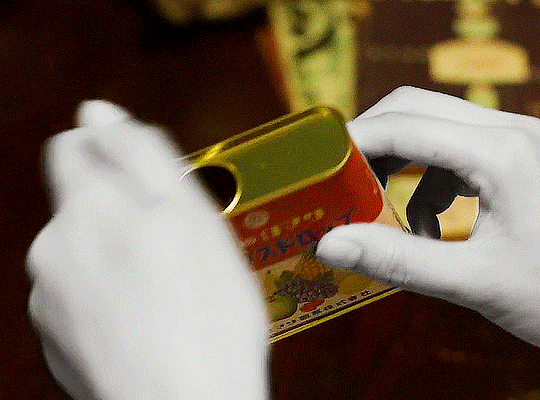
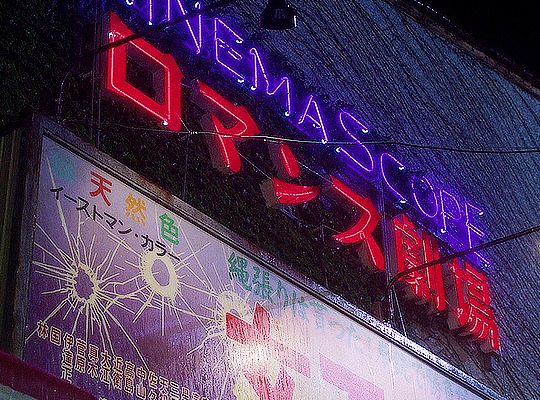


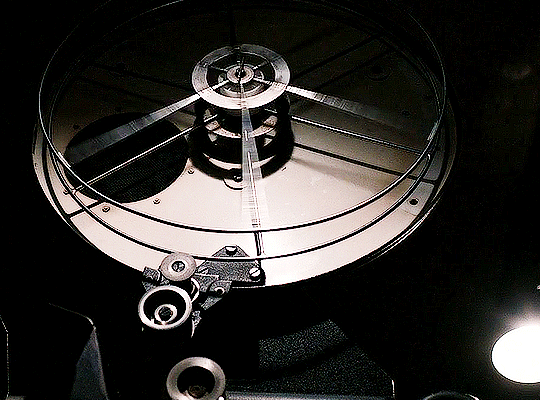


Someone once said that movies had the miraculous power to delight and move us. But in the shadows of these masterpieces are countless more that are simply forgotten. Never seen, never needed. These films are forgotten. Are they worthless now?
COLOR ME TRUE 今夜、ロマンス劇場で
(2018, UYAMA Keisuke)
#color me true#tonight at the movies#konya romansu gekijo de#filmedit#filmgifs#worldcinemaedit#fyeahmovies#jdramaedit#dailyflicks#moviegifs#movieedit#moviehub#userfilm#userbbelcher#ayase haruka#sakaguchi kentaro#my edit#long post
173 notes
·
View notes
Text

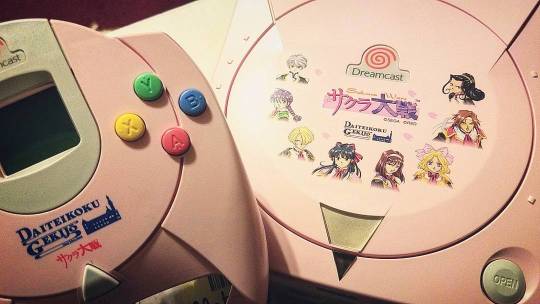
2023-10-08
15 notes
·
View notes
Text
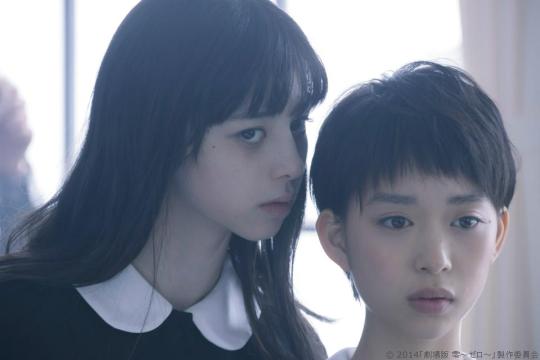
#劇場版 零〜ゼロ〜#fatal frame#gekijô-ban: zero zero#gekijōban zero#gekijoban zero#gekijo-ban zero zero#gekijo-ban: zero zero#mari asato#asato mari#安里麻里#ayami nakajo#nakajo ayami#中条 あやみ#aoi morikawa#morikawa aoi#森川 葵#cinema#japanese#asian#stills#my uploads#horror#lgbtq+
8 notes
·
View notes
Text


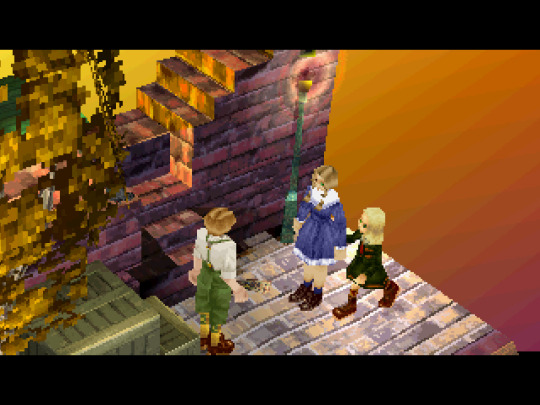

Hey, have you ever wondered what the little known 3D adventure-leaning PlayStation sequel to the 2D SNES RPG Mystic Ark was like? Great! This article's for you:
30 notes
·
View notes
Text
youtube
今日の京は、
hidden one - sukekiyo
#kyo of the day#sukekiyo#dir en grey kyo#sukekiyo takumi#sukekiyo uta#sukekiyo yuchi#sukekiyo mika#Kyoto Gekijo#2014#Youtube
5 notes
·
View notes
Text
Extremely sad that shinshu ueda never did a persona 2 manga along with the persona 1 adaption, partially bc that makes the p2 duology the only game not truly adapted into comic form (anthologies don't technically count since they're one offs, and sin and punishment doesn't cover the story) but also bc her art she has done for p2 is so pretty......

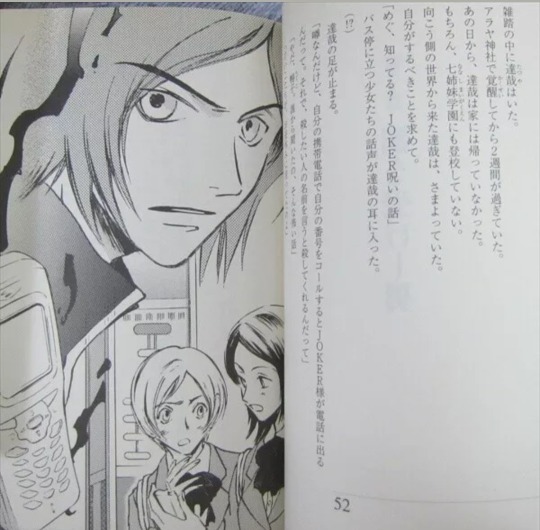
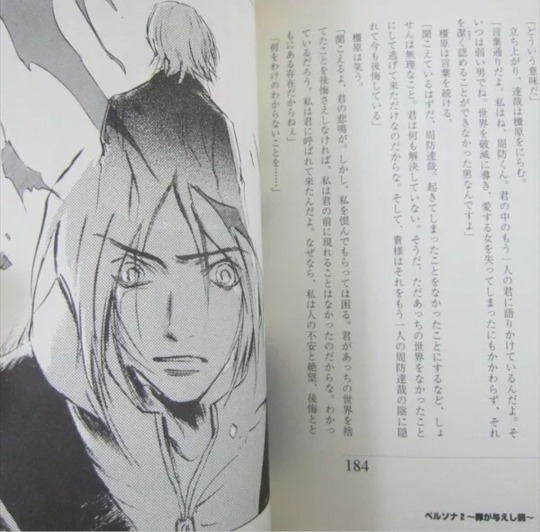

#i dont blame her also bc if you combine the duology its a potentially almost 200 hours and is story heavy#she did do a lot of stuff for the ep novelization and enix supercomic gekijo tho#not shown here is a cover she did of the main is cast for enix and a novel illustration of the is kids covering their ears#shinshu ueda#persona 2
90 notes
·
View notes
Text


Redraw sketches from Takashi miike's Ryu Ga Gotoku film
19 notes
·
View notes
Photo
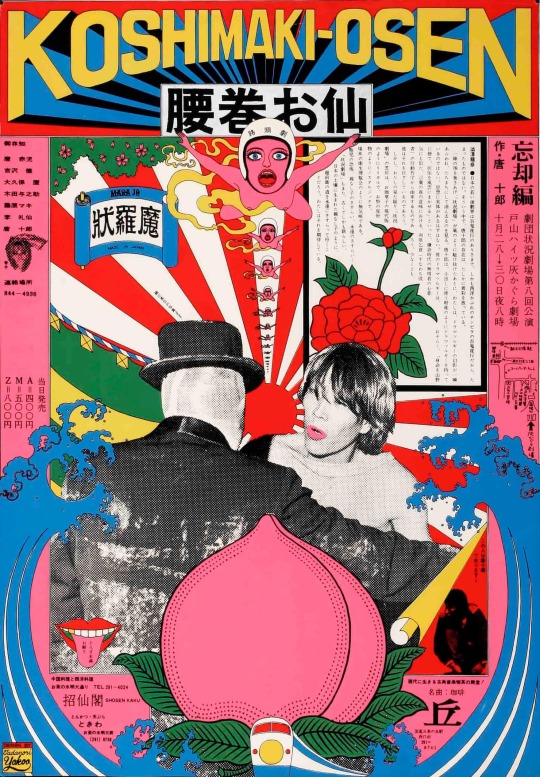
Petticoat Osen: A Tale of Forgetfulness, 1966, Tadanori Yokoo
This poster for Jōkyō Gekijō’s performance of Petticoat Osen is emblematic of Tadanori Yokoo’s playful and subversive approach to design. The bright hues and dynamic composition not only channel the powerful emotions, energy and bravado of Edo-period kabuki theater, but are also representative of an experimental artistic style that combines western imagery with Japanese motifs, symbols and photography, creating a synthesis between avant-garde happenings, consumer culture and everyday objects
Photograph: The Merrill C Berman Collection
#petticoat osen#artist#illustrator#illustration#poster#a tale of forgetfulness#tadanor yokoo#art#jokyo gekijo#the merrill c berman collection#edo-period kabuki theater
1 note
·
View note
Photo

Zombieland Saga fanart illustrated by Odeko Fujii, the mangaka behind series like Fujii Odeko Gekijo & the popular Youjo Shachou ( Cute Executive Officer ) series.
#Zombieland Saga#Zombie Land Saga#ZLS#Sakura Minamoto#Lily Hoshikawa#Saki Nikaido#Junko Konno#Ai Mizuno#Tae Yamada#Yugiri#Kotaro Tatsumi#Romero#industry art#Odeko Fujii#Youjo Shachou
144 notes
·
View notes
Photo
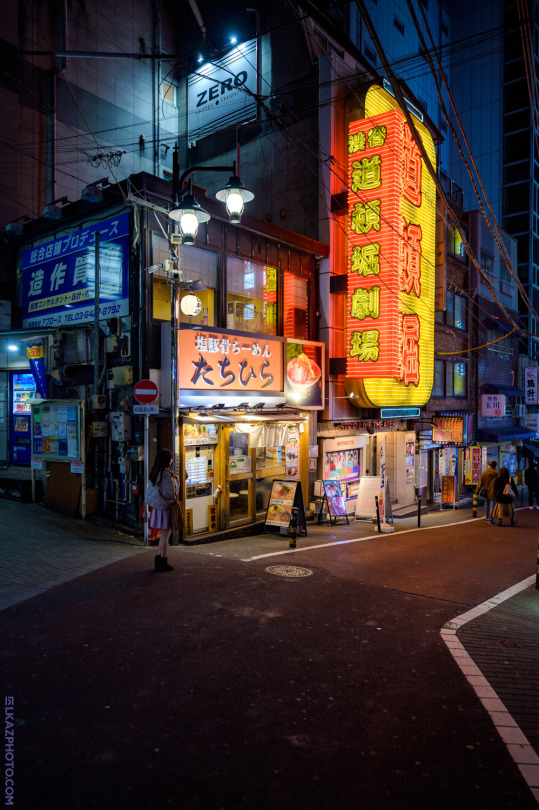
Dotonbori Gekijo, Shibuya 渋谷
#日本#東京#渋谷#japan#tokyo#shibuya#photography#photo#city#night#neon#neo-tokyo#urban#metropolis#Nikon Z6II
642 notes
·
View notes
Text

I recently played through Mystic Ark (1995) each night before bed during the last week or so. I initially saw a promotion for the game next to Terranigma (a longtime favorite) in a Famitsu magazine earlier this year, and got mesmerized by its Labyrinth-esque cover artwork in particular. I immediately knew I had to play whatever this was.
So I took the slowburn approach by first going through The 7th Saga and Brain Lord, two previous games by developers Produce. While not remotely essential for this venture, they still gave me some neat context and groundwork for the game's roots. I think they ultimately helped me appreciate this game all the more.


In Mystic Ark you wake up alone on a desolate eerie island and need to travel to different worlds in search of the titular arks to grow stronger and regain your freedom. These worlds act as self-contained stories with distinct vibes, genres and presentation. It's a delightfully novel idea for a game to take an anthology approach, and I wish more games would attempt this because it's highly effective in keeping up intrigue and wonder. Every time you depart for the next world is a big mystery and you usually need a moment to piece together what each new tale is gonna be about.


For example, the first world is a light hearted tale about war and conflict told through two rivalling factions of pirate cats. The game sees you meandering in back-and-forth fetch quests to support both sides' advances towards the same goal, it has a lot of cheeky humor about this and presents itself in a very cute and endearing fashion.
Another story has you enter a mysteriously abandoned world devoid of even monsters, only populated by a few orphaned children who play in a ghost town by day and then go home to a mansion run by a suspicious nun. As you go along with their antics and babysit them out of dangerous situations, the situation only keeps getting stranger.


One world in particular locks you inside a horror story without your party members, as you work your way through a labyrinthine haunted house by solving puzzles interspersed by ominous scribbles by a paranoid previous resident. The atmosphere hangs heavy and the suspension has you on needles, it's a lovely showcase of Mystic Ark's core concept that it effectively pulls these twists and turns without ever feeling jarring.
One aspect I enjoyed in particular was the semi-point and click flavour in your interactions with the world. Many points will pull up an extra menu with a nice picture of what you're looking at and various options of how to fiddle and prod at it. Supposedly the 1999 Playstation sequel Mystic Ark: Maboroshi Gekijo leaned even further into this, and I'm not at all surprised. Would love to play it whenever someone decides to translate it or I get good enough at Japanese. Whichever one comes first.
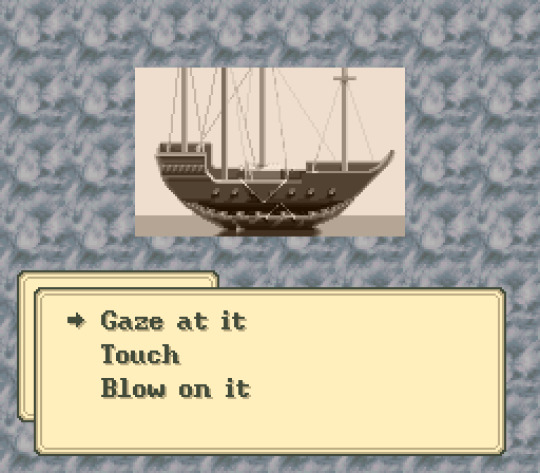

Mystic Ark is a gorgeous and rich experience that continuously rewards the player for sticking with it. Even though the individual tales all have satisfying conclusion, the game still maintains a lot of mystery by keeping the finer points untold. You rarely get the full picture and that only helps to make you keep wondering. The ending to the game itself is as vague as it begins, and allows for many different interpretations. My take is that the game, through its anthology structure, tells us about the many little worlds we can find all around us, the stories that reside in anything. The worlds are entered by interacting with regular objects like a ship model, a painting or a storybook, and recurringly we must return to the island to gather figurines of lost actors in the stories to progress. I think Mystic Ark emphasises the player's power as a sort of story teller, fiddling with the plots in interesting ways, to build a genuine interest. At the end we are seemingly encouraged to take this depiction of narratives and inspiration to go out into our own world and find our own stories to tell.
It's a mesmerizing all-timer and for sure a new favorite of mine.
/Kiki
(Extra note: The game was only released in Japan, so I played a fan translation. There are two of them and after some comparison I went with the one by Dynamic Design because it felt a bit more vibrant and inspired in its word choices. Your preference may differ though and they both seem to be good.)
24 notes
·
View notes
Photo





COLOR ME TRUE 今夜、ロマンス劇場で
(2018, UYAMA Keisuke)
#color me true#tonight at the movies#konya romansu gekijo de#screencaps#film#cinema#dailyworldcinema#japanese cinema#jmovie
162 notes
·
View notes
Text
Listening Post: Les Rallizes Dénudés

It’s difficult to paint an accurate picture of the history of Les Rallizes Dénudés, as an aura of mystery and an inordinate amount of conjecture surround the band. This we do know: Les Rallizes Dénudés sprung from the fertile music scene in late 1960s Japan, in striking opposition to the Group Sounds and folk-rock music that was popular in their country at the time. The original line-up of the band formed in 1967 at Doshisha University in Kyoto, comprising guitarist and vocalist Takashi Mizutani, guitarist Takeshi Nakamura, bassist Moriaki Wakabayashi, and drummer Takashi Katoh. They initially dubbed themselves Hadaka No Rallizes but, according to legend, after Mizutani befriended the radical theater ensemble Gendai Gekijo they became Les Rallizes Dénudés in accordance with the fake French slang that the troupe had invented.
Throughout the band’s three-decades-long existence, they cut a striking figure. Fronted by the long-haired, sunglasses-and-leather wearing Mizutani, Les Rallizes Dénudés took sensory overload to a new level. The band’s live shows were punishingly loud and replete with extreme visual elements. They had a repertoire of just over a dozen songs, but the myriad bootleg recordings that appeared in the band’s wake indicate that Mizutani and company never played a tune the same way twice. Their music seemed deceptively simple, with bass-and-drum vamps that stretched to infinity overtop of which Mizutani unfurled scorching clouds of guitar noise and vocals sung in his native Japanese.
After original bassist Wakabayashi was involved in the hijacking of a plane in 1970, the already enigmatic Mizutani became downright elusive. Outside of their iconoclastic leader, Les Rallizes Dénudés’ membership rotated frequently. Official recordings didn’t appear until 1991, at which time the band issued a trio of CDs compiled from various studio and live recordings from across the first decade of their existence. These quickly disappeared, as the legend of Les Rallizes Dénudés had grown considerably by this time, likely indirectly due to acts like High Rise and Fushitsusha that followed in their wake.
Mizutani passed away in 2019, and shortly thereafter an organization dubbed The Last One Musique appeared, complete with a new website devoted to the band. Earlier in 2022, the Temporal Drift label began issuing Les Rallizes Dénudés material, notably The Oz Tapes and the Oz Days Live compilation, supported by The Last One Musique. In November, the label plans to reissue those first three official releases – ’67-’69 Studio et Live, MIZUTANI / Les Rallizes Dénudés, and ’77 Live – completely remastered and with new liner notes that will hopefully dissolve some of the fog-like mystique surrounding the band.
We here at Dusted have varying levels of affinity for Les Rallizes Dénudés, and felt that through group discussion, we’d be able to approach the music most adroitly. Given the sheer volume of material involved (The Oz Tapes is a double LP, ’77 Live is a triple LP, and the Oz Days Live compilation is a triple CD), we chose to focus on the official releases.
I don’t know about you guys, but that ’77 Live release is what I typically associate with the Les Rallizes Dénudés “sound”. Apparently that Heavier Than a Death in the Family bootleg includes some of this material.
Intro by Bryon Hayes
youtube
Ian Mathers: So, while I'd certainly heard of them (albeit thinking they were French for a bit when all I knew was the name), my first real encounter with Les Rallizes Dénudés was only a few months ago, hearing the Heavier Than a Death in the Family version of "Night of the Assassins" and going “What is THAT?” I hadn't gotten around to investigating much further than that, though, so this Listening Post is both very convenient for me, personally, and also when I started playing '67-'69 Studio et Live and "Les Bulles de Savon / Soap Bubbles" began I was very surprised. Like you, Bryon, '77 LIVE is more what I expected, albeit on far more circumstantial grounds. And while, once I adjusted to the gentler, arguably more dated material on '67-'69 and MIZUTANI / Les Rallizes Dénudés none of it is particularly unpleasant or hard to deal with, it does suffer for me in comparison to '77 LIVE which on first listen is one of my favorite things I've heard all year, maybe longer. The 95-minute length and sheer abrasiveness of its noise means it's not going to be a casual play around my apartment, but I can honestly say I was riveted for every minute the couple of times I've been able to fit it in so far. The length of each track and of the album as a whole is part of what I think is so distinctive and incredible about it.
So if these three official/out of print releases have been around at least to some degree since the early 1990s, is the softer/folkier(?) sound of much of the studio stuff on there a big part of what people like about Les Rallizes Dénudés? I feel like once I heard more than the name I mainly heard people referring to the noisier stuff. And why did it take until this listen to realize that the bassline on what '77 LIVE calls "夜、暗殺者の夜 / The Night, Assassin’s Night" makes me think of that "I Will Follow Him" song from Sister Act?
Mason Jones: I've heard a number of people refer to Rallizes as "Japan's answer to the Velvet Underground," which rings true in part because of the bands formed in their wake. While they were never well-known, perhaps "notorious" is a better description. Their influence leaked out over years, and their shadowy presence and noisy psychedelic swirl can be traced to many independent bands. I doubt that Keiji Haino would regard them as much of an inspiration for Fushitsusha, but there's at least a visual aesthetic that's even more visible in Kousokuya and Kaneko Jutoku's work and lurks behind many other bands related to the PSF label such as Shizuka and High Rise. Some of Japan's psychedelic underground readily admit Rallizes' inspiration, such as LSD March, Up-Tight, and Overhang Party.
Where the Boredoms inspired an entire Kansai scene of anything-goes indie anarchy, Les Rallizes Denudes infiltrated a smaller but no less impactful network of smoke-drenched psychedelic players. The heavier, noisier aspect of Rallizes is better-known outside Japan, but from the deep, slow strums of Suishou no Fune to the quieter aspects of Majutsu no Niwa and LSD March, the softer side is definitely there as well. That said, I've certainly always been more attracted to their more crazed, no-holds-barred work like that on '77 LIVE and bootlegs like Blind Baby Has Its Mothers Eyes. The 1980 Live and Soundboard collection (10 CDRs!) and Double Heads boots are also among the better ones, but in truth over the years it's been nearly impossible to untangle the recordings spread across dozens and dozens of poorly assembled bootleg releases. Seeing properly mastered and collected releases coming out now is very, very welcome.
youtube
Ian Mathers: Which brings up one of the biggest questions I have about all this: how does one “properly” master something like '77 LIVE? I think it sounds fantastic, so I clearly agree with the choices made, but I wonder what's involved and what's different about working with source material like that.
Mason Jones: It's hard to say. In this case, it's possible that they have the original tapes, whereas the versions I've heard before are probably second generation or worse; very possibly duped from an old LP or cassette! However, I'm listening right now and comparing the old Le 12 Mars 1977 à Tachikawa bootleg I have, which is the same as '77 LIVE — same track lengths and all. The older bootleg feels slightly thinner and hissier, but interestingly it doesn't sound as much worse as I recalled. That one has a long history of unofficial re-releases, as shown on its Discogs page. The old bootleg I have of Mizutani is certainly improved on by the new reissue, with a great deal more clarity. I don't seem to have any previous releases that correspond to the '67 - '69 Studio et Live reissue, which is an intriguing collection of ragtag recordings.
The OZ Tapes by Les Rallizes Dénudés
Ethan Covey: It’s funny you mention mastering as there was a minor Twitter flare up a few days back when someone posted a screenshot comparing audio files from the old CD release of ’77 Live with the new edition. It looked as if the dynamic range on the new release was crunched/maxed out/whatever the correct terminology is, versus a more forgiving mix on the CD. And there was the accompanying grumbling that modern mastering — especially on a release like this — is all about volume at the expense of subtlety. I haven’t listened to the new ’77 Live yet but have to say the mastering on The OZ Tapes sounded fantastic compared with previous versions of that material. I look forward to listening to the LP (if it ever arrives), and digging into these “new” ones.
Mason Jones: Yeah, I can see that. Listening to my old CD copy versus the new one, while I haven't compared the files specifically there's certainly more modern compression on the new release. That's fairly typical these days. To my ears, it doesn't seem excessive, but it'll take more listening to let it sink in for sure. I do have to chuckle a bit about the idea of "subtlety" dealing with blown-out live recordings like these. As you say, though, I'm waiting for my LP copies to arrive, which will be a better test than mp3s.
Bryon Hayes: I have a question for Mason and those of you who've been following Les Rallizes Dénudés for some time and have access to recordings from across their existence: these three releases document a band that appears to have experienced a sizeable shift in sound in its first decade of existence, from the almost garage-y tunes of '67-'69 Studio et Live and the softer acoustic sounds of MIZUTANI to the overdriven feedback onslaught that is the '77 Live set. Does anyone know if this was a subtle transition that occurred slowly throughout the decade, or was there a Big Bang moment, with a clear delineation between those two sides of the band?
Mason Jones: That's an interesting question, Bryon. I really don't have a solid answer but can make some guesses. The sequence you list is accurate, and these three albums essentially document three phases of the band: the first lineup from '67 to '69. The acoustic work on Mizutani was him sort of on his own (with some others playing with him) during the period when there wasn't a full band. Then in 1970 he moved to Tokyo and started with a new lineup. Takeshi Nakamura, who started the band with Mizutani, was quoted as saying "The live shows were really high volume from the very beginning" so the shift from garage-y as you describe it to the more out-there tracks might have just happened naturally due to the almost complete change in band members. But who knows, perhaps some of it's simply the selection of tracks we're hearing!
youtube
Ian Mathers: I am sympathetic to "loudness war" type concerns, generally, but I have to admit the notion that the stuff here that I really like would not be brickwalled seems a little funny. Interesting to know that aside from Mizutani himself there was a pretty complete change of personnel; I still kind of wonder, given the more standard/quality production on those earlier records, how much the production, not just the playing, on '77 Live was a deliberate aesthetic choice. Do we know if it's more a case of them playing high-volume shows with recording equipment that just wasn't up to the task, in unexpectedly glorious ways, or is there any indication they were leaning into that part of their sound (whether that's using equipment a step down from what they could, or playing in certain ways, or the recording process, or mixing, or...)? Any answer isn't going to make me like that sound less, to be clear - I have no stake in this being some variety of outsider or accidental art. I do wonder if when they first heard the tapes they went "great!" or "oh no..." though.
Mason Jones: Yeah, it's hard to say whether the sound was intentional or not. In the case of the live recording, it's worth keeping in mind that in Japan it's unusual for bands to have their own equipment aside from the instruments and effects -- the live houses have amps and drums that the bands use. Since so few people drive, it's uncommon to be able to bring your own stuff. That means the amps they were using would have been the house amps, although '77 Live was recorded at Tachikawa Social Education Hall; who knows if they had a regular backline or rented equipment for the show. In any case, who knows how they felt about the tapes when they first heard them.
The overblown sound, though, was almost certainly the primary influence for Nanjo Asahito's recording and mastering approach for the first High Rise albums and later work that he did. Those recordings were infamous for the brick wall limiting, pushing everything into the red. I don't know for certain but given Nanjo's appreciation for Rallizes I'd be shocked if the sound of '77 Live wasn't the initial inspiration for that approach.
Bryon Hayes: According to the information I've scrounged online, not only was the band notoriously loud, but they were also accompanied by a frenzied lightshow, beginning with their earliest performances. Apparently Mizutani coined the term "total sensory assault" to describe the experience and it is claimed that was the goal from the start. Of course, given the amount of speculation and conjecture that surrounds the band, this could be a red herring. In some respects, I hope that as Temporal Drift release more material, the mystery will slowly unravel, but I also kind of enjoy the mystique.
32 notes
·
View notes
Text
youtube
"Engine Formation Lap: Gekijo Bang Custom", from Engine Sentai Go-Onger: Boom Boom! Bang Bang! Gekijo Bang!" (2008). Performed by Project.R and Engine Kids.
5 notes
·
View notes